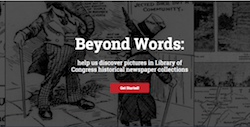At a Glance
Description
Transcibe WWI era newspaper images and increase access to historical collections.
Website
Producer
Beyond Words

The Library of Congress's LC Labs has created the crowdsourcing pilot project Beyond Words that lets users identify and transcribe World War I era images in Chronicling America's historical newspaper collection.
This community engagement project is built using the Scribe codebase and allows for the exploration of historical illustrations, political cartoons, and photographs in newspapers published between 1914-1918. Users can choose among three main actions in Beyond Words. In the "Mark" section, users identify historical images by state newspapers and draw boxes around them. "Transcribe" allows users to record captions, creators, and category of image. "Verify" gives users the ability to edit transcriptions and choose the best one before the catalogued image is added to the Beyond Words public dataset and Image Gallery.
Beyond Words has many useful applications for the classroom. The "Mark" section enables users to choose and box the newspaper images such as illustrations, photographs, and cartoons, but not images used in newspaper advertisements. This means that teachers can use this section to improve students' primary source analysis skills as students would have to think carefully about what type of image they are marking. The "Transcribe" section would further enhance students' critical thinking skills because they must examine each part of the primary source to document the image's creator, the captions, as well as the type of image. Students could then use the "Verify" section to assess other's transcriptions.
Beyond Words is also a great project to introduce to students studying World War I. The images and newspaper pages contained in the codebase are all linked to the original digitized newspaper in Chronicling America. Students could use Beyond Words to jump start a research project on political cartoons during World War I, or how news coverage of the war changed over time. Since this project is crowdsourced, students would enrich their primary source analysis skills and knowledge of World War I at the same time that they are contributing to this public history project and increasing others' access to new knowledge.